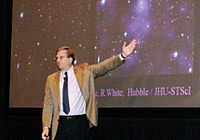Director's Corner
22 February 2007
 Barry Barish |
The Road to the ILC: Convincing our Colleagues
Now that we have released our draft Reference Design Report for the ILC, our short-term focus is on completing and finalising the RDR. This will involve completing some unfinished work, undergoing international reviews and then revising and finalising the reference design and costing. We are scheduled to submit the report to the ILCSC and ICFA at their meetings this summer. We are also busy discussing and preparing for the engineering design phase and its associated R&D, which will require increased resources and some reorganisation of our efforts. The release of the RDR also increases the opportunities for us to explain the scientific motivation for developing the ILC as a future global science project. For example, we participated in a special session on future frontiers in particle physics organised at the annual meeting of the American Association for the Advancement of Science (AAAS) in San Francisco last week.
 Jon Bagger presented the ILC at the AAAS annual meeting. |
The AAAS is more than 150 years old and has a stated mission to “ advance science and serve society” through initiatives that include science policy, international programmes, science education and public understanding of science. It is the largest general science organisation in the world and publishes the highly respected journal Science. Every annual meeting of the AAAS is very well attended and covers a very broad range of topics. This year’s meeting provided an excellent venue for us to present the ILC to a broad science-related audience. Our session was called “A New Frontier in Particle Physics.”
The session, held before a packed room, highlighted the imminent turn-on of the Large Hadron Collider including a talk by Albert de Roeck (CERN), who boldly predicted that “the LHC will reveal the origin of mass in our Universe.” He was followed by Jon Bagger (Johns Hopkins University), who acknowledged that the Higgs is close at hand, but then went on to question whether that will be the end or the beginning of the story. Jon made a strong case for the ILC: “But is a ‘Higgs’ the Higgs? Is it the only Higgs? Does it have the correct spin? Does it have the correct couplings?” The session concluded with Nobel laureate Burton Richter giving his own individual view of the future of particle physics.
Carrying out such dialogues and sharing the science questions we are probing with the broader science community is an effective and essential way to engage a larger audience in our adventure and gather the support we will need when the time comes to propose the ILC.
Thanks, Jon. Job well done!
-- Barry Barish